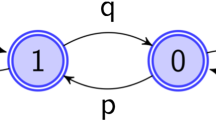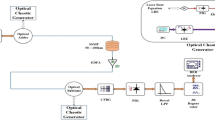Abstract
In this paper, the key technologies and research progress of chaotic optical communication are reviewed. We first discuss the chaos generation methods based on different nonlinear components. Then we focus on the frontiers of chaotic optical communications, including how to improve the security, and the development about the transmission capacity and distance of chaotic optical communication in laboratory and field. At last, we discuss limitations and potentials of chaotic optical communications and draw a conclusion.
Similar content being viewed by others
References
Maiman T H. Optical and microwave-optical experiments in ruby. Physical Review Letters, 1960, 4(11): 564–566
Lorenz E N. Deterministic nonperiodic flow. Journal of the Atmospheric Sciences, 1963, 20(2): 130–141
Haken H. Analogy between higher instabilities in fluids and lasers. Physics Letters A, 1975, 53(1): 77–78
Pecora L M, Carroll T L. Synchronization in chaotic systems. Physical Review Letters, 1990, 64(8): 821–824
Argyris A, Syvridis D, Larger L, Annovazzi-Lodi V, Colet P, Fischer I, García-Ojalvo J, Mirasso C R, Pesquera L, Shore K A. Chaos-based communications at high bit rates using commercial fibre-optic links. Nature, 2005, 438(7066): 343–346
Lavrov R, Jacquot M, Larger L. Nonlocal nonlinear electro-optic phase dynamics demonstrating 10 Gb/s chaos communications. IEEE Journal of Quantum Electronics, 2010, 46(10): 1430–1435
Masoller C. Anticipation in the synchronization of chaotic semiconductor lasers with optical feedback. Physical Review Letters, 2001, 86(13): 2782–2785
Wu Y, Wang Y, Li P, Wang A, Zhang M. Can fixed time delay signature be concealed in chaotic semiconductor laser with optical feedback? IEEE Journal of Quantum Electronics, 2012, 48(11): 1371–1379
Rontani D, Locquet A, Sciamanna M, Citrin D S, Ortin S. Timedelay identification in a chaotic semiconductor laser with optical feedback: a dynamical point of view. IEEE Journal of Quantum Electronics, 2009, 45(7): 879–891
Ortín S, Gutiérrez J M, Pesquera L, Vasquez H. Nonlinear dynamics extraction for time-delay systems using modular neural networks synchronization and prediction. Physica A: Statistical Mechanics & Its Applications, 2005, 351(1): 133–141
Nguimdo R M, Soriano M C, Colet P. Role of the phase in the identification of delay time in semiconductor lasers with optical feedback. Optics Letters, 2011, 36(22): 4332–4334
Rontani D, Locquet A, Sciamanna M, Citrin D S. Loss of time-delay signature in the chaotic output of a semiconductor laser with optical feedback. Optics Letters, 2007, 32(20): 2960–2962
Uchida A. Optical Communication with Chaotic Lasers. Hoboken: Wiley, 2012
Goedgebuer J P, Levy P, Larger L, Chen C C, Rhodes W T. Optical communication with synchronized hyperchaos generated electrooptically. IEEE Journal of Quantum Electronics, 2002, 38(9): 1178–1183
Nguimdo R M. Chaos and Synchronization in opto-electronic devices with delayed feedback. Dissertation for the Doctoral Degree. Illes Balears: Universitat de les Illes Balears, 2011
Nourine M, Chembo Y K, Larger L. Wideband chaos generation using a delayed oscillator and a two-dimensional nonlinearity induced by a quadrature phase-shift-keying electro-optic modulator. Optics Letters, 2011, 36(15): 2833–2835
Lavrov R, Peil M, Jacquot M, Larger L, Udaltsov V, Dudley J. Electro-optic delay oscillator with nonlocal nonlinearity: optical phase dynamics, chaos, and synchronization. Physical Review E: Statistical, Nonlinear, and Soft Matter Physics, 2009, 80(2): 026207
Nguimdo R M, Verschaffelt G, Danckaert J, Van der Sande G. Loss of time-delay signature in chaotic semiconductor ring lasers. Optics Letters, 2012, 37(13): 2541–2543
Hou T, Yi L, Ke J. Time delay signature concealment in chaotic systems for enhanced security. Submitted to Photonics Research, 2016
Hizanidis J, Deligiannidis S, Bogris A, Syvridis D. Enhancement of chaos encryption potential by combining all-optical and electrooptical chaos generators. IEEE Journal of Quantum Electronics, 2010, 46(11): 1642–1649
Nguimdo R M, Colet P, Larger L, Pesquera L. Digital key for chaos communication performing time delay concealment. Physical Review Letters, 2011, 107(3): 034103
Nguimdo R M, Colet P. Electro-optic phase chaos systems with an internal variable and a digital key. Optics Express, 2012, 20(23): 25333–25344
Aromataris G, Annovazzi-Lodi V. Enhancing privacy of chaotic communications by double masking. IEEE Journal of Quantum Electronics, 2013, 49(11): 955–959
Ursini L, Santagiustina M, Annovazzi-Lodi V. Enhancing chaotic communication performances by Manchester coding. IEEE Photonics Technology Letters, 2008, 20(6): 401–403
Van Wiggeren G D, Roy R. Communication with chaotic lasers. Science, 1998, 279(5354): 1198–1200
Anishchenko V S, Vadivasova T E, Postnov D E, Safonova M A. Synchronization of chaos. International Journal of Bifurcation and Chaos in Applied Sciences and Engineering, 1992, 2(3): 633–644
Colet P, Roy R. Digital communication with synchronized chaotic lasers. Optics Letters, 1994, 19(24): 2056–2058
Larger L, Goedgebuer J, Udaltsov V. Ikeda-based nonlinear delayed dynamics for application to secure optical transmission systems using chaos. Comptes Rendus Physique, 2004, 5(6): 669–681
Annovazzi-Lodi V, Donati S, Scire A. Synchronization of chaotic lasers by optical feedback for cryptographic applications. IEEE Journal of Quantum Electronics, 1997, 33(9): 1449–1454
Goedgebuer J P, Larger L, Porte H. Optical cryptosystem based on synchronization of hyperchaos generated by a delayed feedback tunable laser diode. Physical Review Letters, 1998, 80(10): 2249–2252
Mirasso C R, Colet P, Garcia-Fernandez P. Synchronization of chaotic semiconductor lasers: application to encoded communications. IEEE Photonics Technology Letters, 1996, 8(2): 299–301
Uchida A, Sato T, Kannari F. Suppression of chaotic oscillations in a microchip laser by injection of a new orbit into the chaotic attractor. Optics Letters, 1998, 23(6): 460–462
Fischer I, Yun L, Davis P. Synchronization of chaotic semiconductor laser dynamics on subnanosecond time scales and its potential for chaos communication. Physical Review A (Atomic, Molecular, and Optical Physics), 2000, 62(1): 011801/1–4
Sivaprakasam S, Shore K A. Message encoding and decoding using chaotic external-cavity diode lasers. IEEE Journal of Quantum Electronics, 2000, 36(1): 35–39
Tang S, Liu J M. Message encoding-decoding at 2.5 Gbits/s through synchronization of chaotic pulsing semiconductor lasers. Optics Letters, 2001, 26(23): 1843–1845
Abarbanel H, Kennel M B, Illing L, Tang S, Chen H F, Liu J M. Synchronization and communication using semiconductor lasers with optoelectronic feedback. IEEE Journal of Quantum Electronics, 2001, 37(10): 1301–1311
Kusumoto K, Ohtsubo J. 1.5-GHz message transmission based on synchronization of chaos in semiconductor lasers. Optics Letters, 2002, 27(12): 989–991
Argyris A, Hamacher M, Chlouverakis K E, Bogris A, Syvridis D. Photonic integrated device for chaos applications in communications. Physical Review Letters, 2008, 100(19): 194101
Annovazzi-Lodi V, Benedetti M, Merlo S, Norgia M, Provinzano B. Optical chaos masking of video signals. IEEE Photonics Technology Letters, 2005, 17(9): 1995–1997
Argyris A, Grivas E, Hamacher M, Bogris A, Syvridis D. Chaos-ona- chip secures data transmission in optical fiber links. Optics Express, 2010, 18(5): 5188–5198
Gastaud N, Poinsot S, Larger L, Merolla J M, Hanna M, Goedgebuer J P, Malassenet F. Electro-optical chaos for multi-10 Gbit/s optical transmissions. Electronics Letters, 2004, 40(14): 898–899
Author information
Authors and Affiliations
Corresponding author
Additional information
Junxiang Ke received the bachelor degree in electronic science and technology from Department of Optoelectronic Information in the University of Electronic Science and Technology of China (UESTC) in 2015. He is now pursuing his Ph.D. degree in information and communication engineering in the State Key Lab of Advanced Optical Communication Systems and Networks. His main research field is chaotic optical communication.
Lilin Yi received the B.S. and M.S. degrees from Shanghai Jiao Tong University in China on 2002 and 2005, respectively. He achieved the Ph.D. degree from Ecole Nationale Supérieure des Télécommunications (ENST, currently named as Telecom ParisTech), France and Shanghai Jiao Tong University on 2008 as a joint-educated Ph.D. student. After graduation, he worked at Avanex R&D center as a product development manager for optical amplifier design and management. Since 2010, he joined Shanghai Jiao Tong University as a faculty. Currently, he is a full professor. His main research topics include optical signal processing, high-speed optical access networks and secure optical communications. Dr. Yi is the author and coauthor of more than 100 papers in peer-reviewed journals and conferences, including 3 invited papers and 20 invited talks, which have been cited by more than 1200 times (Google Scholar). Dr. Yi achieved the awards of “National excellent PhD thesis in China” and “National Science Fund for Excellent Young Scholars of China”. He is the track/symposium co-chairs of IEEE CSN&DSP2012, ICCC2014, OECC2015, PIERS2016, the local organizing committee secretary of ACP2014 and the TPC member of ACP2016, ICOCN2016, OFC2017.
Tongtong Hou is a master candidate at Shanghai Jiao Tong University (SJTU). She received her B.S. (2014) degree from the Ocean University of China and continues her study for a master’s degree in the State Key Laboratory of Advanced Optical Communication Systems and Networks. Her research interest is optical secure communications, especially on chaotic optical communication.
Weisheng Hu received the B.S. (86), M.S. (89), and Ph.D. (94) degrees from Tsinghua, Bei**g, University of Science and Technology (BUST), and Nan**g University. He joined Wuhan University of Science and Technology as assistant professor in 1989–1994, SJTU as post-doctorate fellow in 1997–1999, and as professor in 1999. He was director of the State Key Lab of Advanced Optical Communication Systems and Networks (2003–2007), member of coordinate task force of CAINONet and 3Tnet (1999–2006), and technology forecast of Shanghai (2004–). He serves TPC for OFC, APOC, Optics East, LEOS/PS, CLEO/PS, ICICS, and editorial board for JLT, COL, and FOE. He led and participated 32 grants supported by NSFC, 863, MOE, and Shanghai. He received one National Award and three Provincial/Ministry Awards for Science and Technology Progress.
Rights and permissions
About this article
Cite this article
Ke, J., Yi, L., Hou, T. et al. Key technologies in chaotic optical communications. Front. Optoelectron. 9, 508–517 (2016). https://doi.org/10.1007/s12200-016-0570-y
Received:
Accepted:
Published:
Issue Date:
DOI: https://doi.org/10.1007/s12200-016-0570-y




